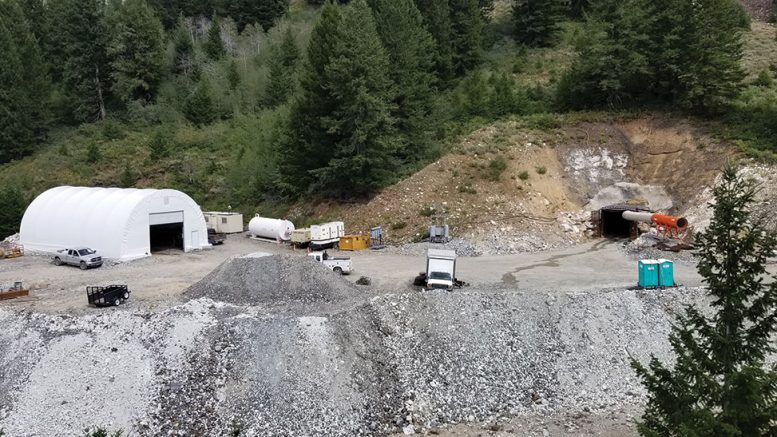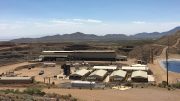Since B2Gold (TSX: BTO; NYSE: BTG) launched BeMetals (TSXV: BMET) two years ago as a base-metals-focused junior, the company has picked up a development-stage zinc-silver project in southwestern Idaho called South Mountain.
Originally floated in early 2018 on the early-stage Pangeni copper project in Zambia, BeMetals wanted to add more advanced-stage base metal projects to its portfolio and in early 2019 acquired a two-year option to secure 100% of the past-producing South Mountain property from Thunder Mountain Gold (TSXV: THM).
Historic underground operations at South Mountain were small-scale but high grade, with over 48,000 tonnes of ore mined at an average grade of 14.5% zinc from 1941 to 1953. Some of the material was reportedly direct shipping ore sent to smelters across the United States.

At BeMetals’ South Mountain zinc-silver project in southwestern Idaho. From front: President and CEO John Wilton; technical advisor Richard Sillitoe; and project geologist Tyson Forbush. Credit: BeMetals.
Last year BeMetals commissioned a technical study on South Mountain that delivered a modest measured and indicated resource estimate of 154,000 tonnes grading 17.7% zinc-equivalent (10.7% zinc, 165 grams silver per tonne, 2.2 grams gold per tonne, 0.8% lead and 0.7% copper), plus additional inferred resources of 329,000 tonnes at 16.6% zinc-equivalent (9.7% zinc, 192 grams silver per tonne, 1.5 grams gold per tonne, 1.2% lead and 0.7% copper).
South Mountain is the sixth-highest zinc-equivalent grade project in North America among 83 projects, the company says, and it is focused on expanding the small initial resource to ultimately feed into a preliminary economic assessment study in 2021.
“What we were trying to do was find advanced projects — something we could push forward quickly into production if it passes all the hurdles,” John Wilton, BeMetals’ president and CEO, said in an interview. “We really liked South Mountain based on the grade, as it’s at over 17% zinc-equivalent. Its got a strong zinc credit to start with in the double digits, but it’s also got a very interesting precious metal content, with a relatively high silver and important gold credit that we found in our drilling last year.”
BeMetals’ 2019 phase one drill program consisted of 20 underground holes totalling 2,250 metres. The program was designed to test potential extensions of mineralized zones and confirm grade distribution within the mineral resource estimate. Results confirmed historic grades and demonstrated additional depth potential, as demonstrated in hole SM19-014, which tested the projected extension of the DMEA zone and returned 15.1 metres grading 9.6% zinc, 127 grams silver per tonne, 1.5 grams gold per tonne, 0.7% lead and 0.3% copper. The bulk of the company’s drill results returned high-grade mineralized intervals outside of the current resource shell.
Drilling also confirmed copper-rich mineralization in the Texas zone of the deposit, with hole SM19-010 returning intervals of 7.2 metres of 4.4% zinc, 155 grams silver per tonne and 2.1% copper, plus an additional 10-metre interval of 1.75% copper, all associated in a skarn-hosted chalcopyrite mineralized zone.
The company believes there is zonation to the deposit that it will further test in its phase two drill program this year. It plans up to 5,000 metres of drilling plus metallurgical testing. BeMetals will also evaluate potential underground development extension out to the Texas zone, in the southeastern portion of the deposit, where the company has been getting higher grade copper results.
Wilton described underground conditions at South Mountain as good with no adverse water or rock mechanics issues.
“The bulk of the drilling will be from underground, which gives us an obvious advantage because we’re close to the mineralization and don’t have to drill through lots of hanging wall stratigraphy,” he explained. “These are fairly discrete targets and very high grade in nature — that’s the trade-off. But the fact that we’re underground means we can drill at good rates and that’s attractive. And once we’ve built up a critical resource base, having that underground development will be a huge benefit to getting this project up and running.”

An underground drill site at South Mountain. Credit: BeMetals.
Despite the current weak zinc market, Wilton is optimistic about the project given its potential by-products. “It will remain a zinc project — the bulk of the value is in the zinc — but on a dollar per tonne value we’ve got some really high values and a significant portion of that comes from the silver, and important in the DMEA zone seems to be the gold credit.”
Wilton also notes that the operating environment in Idaho has been very good, with most permits in place and strong community support for the project. “From a permitting point of view, having all the property on patented claims is a big advantage and it’s an underground project and was a past producer,” he said. “We can get this project moving forward in a rapid manner.”
Outside of Idaho, BeMetals plans about 3,500-4,000 metres of air-core drilling this year at its Pangeni project in the Zambian Copperbelt. The drill program will test around successful drill core results from 2019 that returned up to 0.53% copper over 5.5 metres.
The company uses air-core drilling as an exploration tool at the copper project, which is covered under a thin layer of Kalahari Desert sand. In 2018 it completed 113 air-core holes, which resulted in the three targets that were core drilled in 2019.
The company can earn up to a 72% interest in the project under a five-year option agreement.

Core samples from the South Mountain project. Credit: BeMetals.
Since its creation, the company has raised $8.5 million and has had support from the founders and principals of B2Gold.
Clive Johnson, B2Gold’s president and CEO, has been an active buyer of BeMetals stock and owns 9.7 million shares representing about 9.3%.
BeMetals reports that roughly 28% of its shares are owned by insiders and advisors.
Shares of BeMetals traded at 22¢ at press time, near the bottom of its 52-week trading range of 20¢-29¢, giving the company a $23 million market capitalization based on its 105 million common shares outstanding.




Be the first to comment on "BeMetals looks to development path in Idaho"